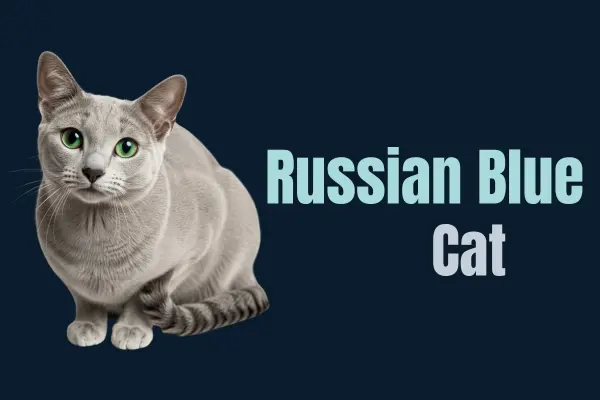Russian Blue Cat Shedding: A 2025 Owner’s Handbook
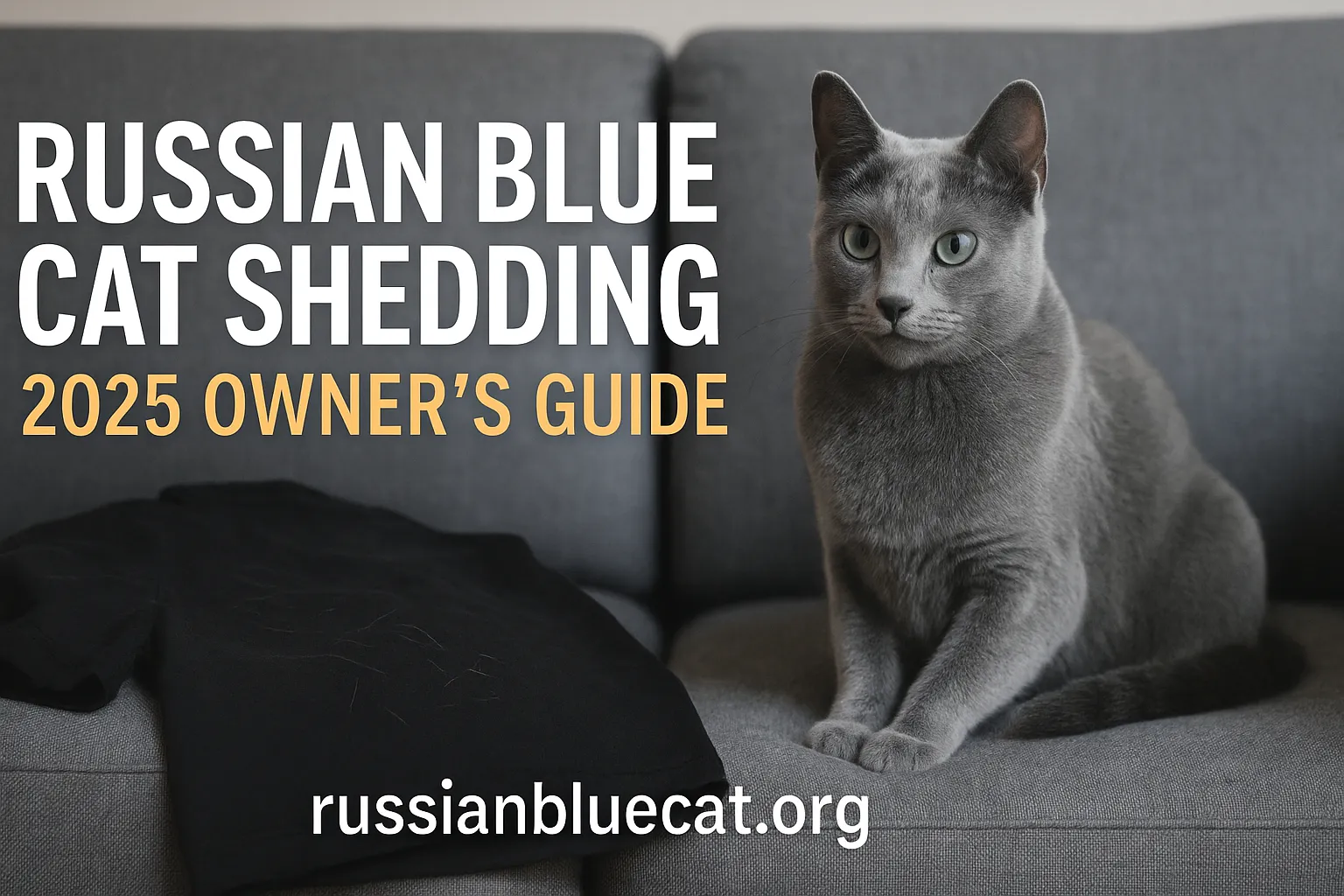
Introduction: Living With a Blue Velvet Companion
Imagine this: a peaceful evening, the warm light of a lamp, and your Russian Blue draped elegantly on the arm of your couch. Its thick, blue-gray coat appears so soft and beautiful that you almost start to think the hype you read on the internet is true “Russian Blue Cats don’t shed.” But when you get up afterwards, you notice a few delicate silver hairs on your clothing. That’s the moment every owner knows the truth: Russian Blue Cat shedding exists.
The good news? In relation to most cats, it’s minimal, manageable, and easy to care for. Learning why shedding occurs, how much is natural, and what you can do about it is the secret to enjoying life with this stunning breed.
The Science Behind the Russian Blue Coat
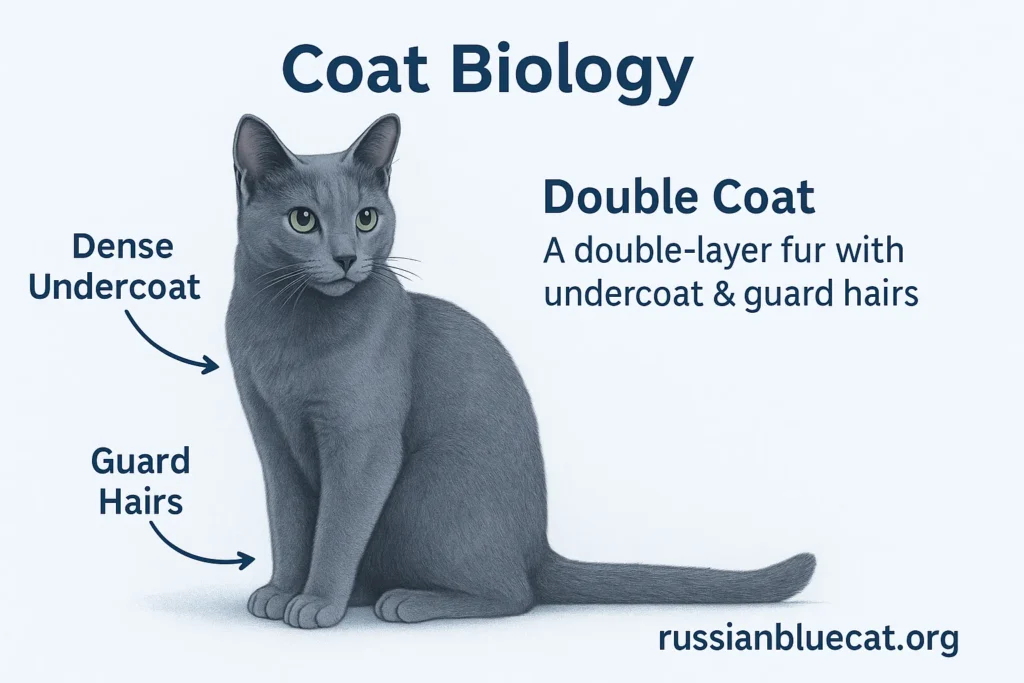
Double Coat Structure
The Russian Blue is one of the few cats with a dense double coat. The outer guard hairs are short, straight, and evenly colored in blue-gray. The undercoat is even denser, soft, and silvery, producing the celebrated shimmering effect.
Velvety Texture
Stroking a Russian Blue is said to be similar to running your hand over velvet. That rich texture is due to the compact undercoat.
Evolutionary Function
This breed originated in northern Russia, specifically Arkhangelsk, where harsh winters necessitated natural protection. The double coat kept them alive in adverse climates something that continues to affect their shedding cycles today.
Once you know this biology, Russian Blue Cat shedding is no surprise. That dense double coat must regenerate itself in order to remain healthy.
Do Russian Blue Cats Shed a Lot? (The Truth Behind the Myth)
If you’ve done some surfing on cat forums, you’ve likely read statements such as “Russian Blues do not shed” or “They’re hypoallergenic so you’ll not have fur hanging around your house.” They’re myths.
Here’s reality
- Yes, Russian Blue Cats do shed. All cats shed in order to replace old hair.
- No, they do not shed excessively. In comparison with Persians or Maine Coons, their shedding is moderate.
- Yes, it can be managed. With weekly brushing and a healthy diet, most owners report the hair in the house barely being evident.
Consider this: if you’re wearing a black shirt, you’ll probably catch a few silver hairs by the end of the day, but it won’t flood you like it would with a heavy-shedding long-haired breed.
Seasonal Shedding Patterns
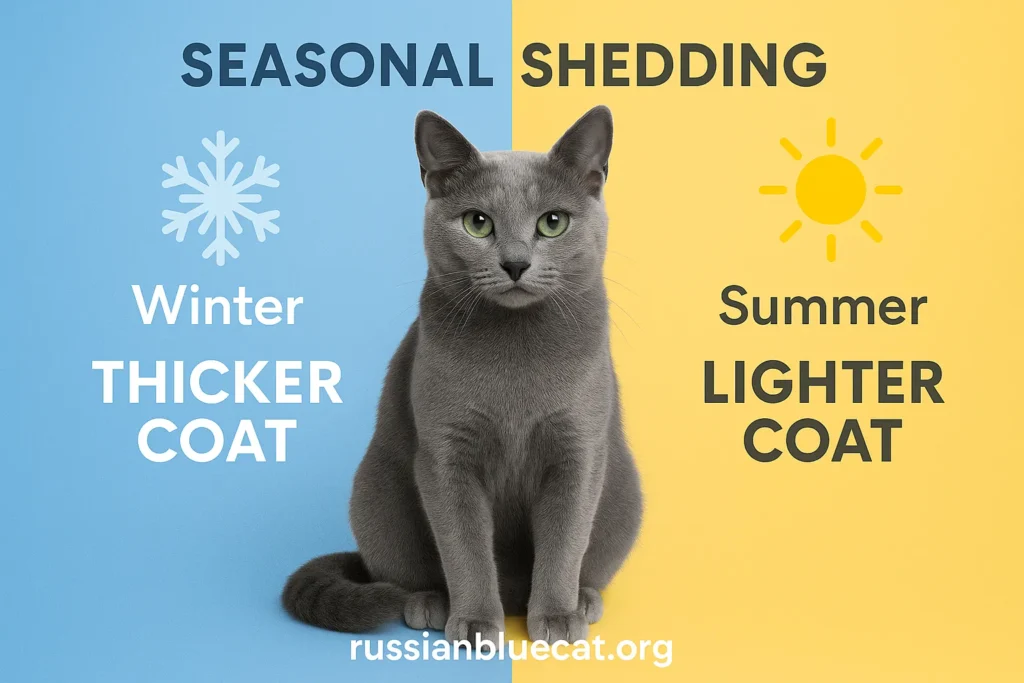
One of the most interesting aspects of Russian Blue Cat shedding is how it tracks the seasons, consistent with the breed’s arctic heritage.
- Spring: A dramatic surge in fur in April or May. Your cat is shedding its heavy winter coat to gear up for warmer temperatures.
- Summer: Light shedding, primarily maintenance-level.
- Fall: Another surge, although typically less extreme than spring. The coat grows heavier to prepare for cold weather.
- Winter: Low shedding; coat remains thick to keep warm.
Owner Pro Tip: In spring and autumn, change to daily brushing. Not only does it cut down on the hair in your house, but it also tightens the bond between you and your Russian Blue. Even many cats begin to anticipate grooming time as a sign of affection.
Why Shedding Occurs: Beyond the Obvious
Although seasonal is the largest trigger, other factors affect Russian Blue Cat shedding:
- Natural Renewal Cycle: Each hair strand has a life cycle. Hairs grow old and fall off to give space to new ones.
- Indoor vs. Outdoor Lifestyle: Indoor domestic cats potentially shed more evenly throughout the year with the assistance of artificial light and climate control.
- Diet and Hydration: Poor nutrition or lack of water can make shedding worse.
- Stress: Believe it or not, cats shed more when anxious. A move, new pet, or loud noise can trigger excess fur loss.
Owner Story: “Less Fur, More Sparkle”
One Russian Blue owner told us: “I used to have a long-haired cat and there was hair everywhere couches, carpets, even my coffee cups! With my Russian Blue, it’s not like that. I still get hair on my clothes, but it’s so light and silky, it sparkles in the sun. Grooming is more like quality time than a chore.”
This is the charm of Russian Blues. Shedding is not a war; it’s a part of the breed’s beauty.
Grooming: The First Line of Defense Against Shedding
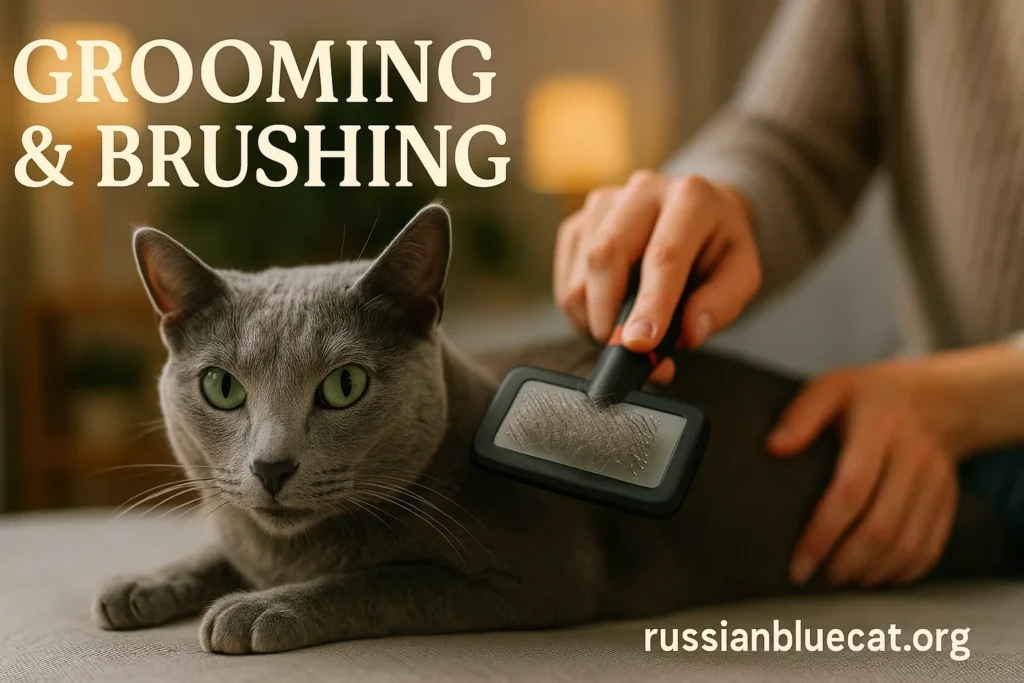
Any Russian Blue owner you ask about their tip for a tidy home will tell you the same thing: grooming. Although the breed does not shed much, regular maintenance makes all the difference.
Brushing
- How frequently? Twice or thrice a week in normal months, every day in shedding months (spring and autumn).
- Ideal tools: A slicker brush for the outer coat and a fine-tooth comb for the dense undercoat.
- Tip: Brush softly in the direction of fur growth. Russian Blues have sensitive skin underneath that thick coat.
Most owners call grooming sessions “therapy” for human and cat alike. The cat receives attention, and you don’t have loose fur drifting around your home.
Bathing
Russian Blues are well-known clean cats. They do not typically require many baths, but with excessive Russian Blue Cat shedding months, a mild bath with a feline-safe shampoo can loosen old fur. Once every 3–4 months is typically sufficient.
Pro Tip: Massage and lift out loose hair with a rubber grooming glove in the bath. Check our detailed guide on Russian Blue Cat Grooming.
Diet: Feeding the Coat From the Inside Out

Shedding is not merely a matter of brushing it begins in the food bowl. A glossy, low-shed coat is more likely to be the result of proper nutrition.
Protein Power
Cats are obligate carnivores. A diet of protein (chicken, turkey, salmon) ensures strong, healthy fur. Deficient protein = frail strands which fall out too easily.
Essential Fatty Acids
- Omega-3 (salmon oil, fish oil): Decreases dryness and inflammation.
- Omega-6 (chicken fat, safflower oil): Maintains the softness and shine of the fur.
A Russian Blue that is fed well will have a coat that shimmers like silver and sheds less in general.
Hydration Counts
Cats frequently do not drink sufficient water. Dehydration causes fur to become brittle and shedding to rise.
Solutions:
- Position several water bowls throughout the house.
- Buy a cat fountain Russian Blues frequently have trouble resisting running water.
- Intermix wet food with their foods.
Home Management: Managing Shedding
Despite grooming and diet, some hair will find its way out. Here’s how to manage it.
Smart Cleaning Tools
- HEPA-filter vacuum: Traps fur + allergens.
- Lint rollers: A must if you wear black clothing.
- Wash your bedding weekly: Your cat’s as well as yours if they sleep with you.
Furniture Protection
In heavy Russian Blue Cat shedding seasons, employ slipcovers or dog blankets on sofas. They can be easily cleaned and prevent hair from becoming lodged in upholstery.
Hypoallergenic Claims: The Reality Check
Part of why Russian Blues are so popular is that they’re said to be “hypoallergenic.” Let’s get real about it.
- Reality: They release less of the Fel d 1 protein (primary allergen in cat allergies) than some breeds.
- Truth: Their dense, short coat results in less floating fur.
- Myth: They are totally allergy-proof.
For light allergy victims, Russian Blue Cat shedding is usually manageable with regular grooming and cleaning habits. But severe cat allergy sufferers can still be affected.
Expert Tip: Regular brushing, HEPA air purifiers, and a bedroom where no fur dares to tread are the recipe for reducing allergy woes in sensitive households.
Owner Story: From Overwhelmed to Organized
Emma, a New York Russian Blue owner, recounted her experience:
“At first, when I brought Luna home, I panicked. Russian Blues don’t shed, or so I thought, and in a week I had silver hairs on my couch. I almost wished I had not brought it home. But after I began brushing every day in spring, changed its food to a salmon-based one, and purchased a tiny handheld vacuum cleaner, everything improved. Now shedding isn’t an issue it’s become routine.”
Her tale demonstrates reality: Russian Blue Cat shedding is not zero, but it’s under control with a systematic approach.
When Shedding Is a Sign of a Health Issue
Russian Blue Cat shedding is usually seasonal, predictable, and manageable most of the time. However, in some cases, heavy fur loss is a warning sign. Here’s when to be concerned:
- Bald Spots: If you see uneven spots of missing hair, seek out a vet.
- Constant Scratching: May be a sign of fleas, mites, or skin allergies.
- Excessive Dandruff: Dry coat can aggravate shedding, and could indicate dehydration or inadequate nutrition.
- Stress Shedding: Anxious cats shed more. Changing residences, new animals, or even a thunderstorm can cause sudden hair loss.
Pro Tip: Visit the vet once a year. A cursory skin and coat inspection usually uncovers issues before they become severe.
Allergy-Friendly Living With a Russian Blue
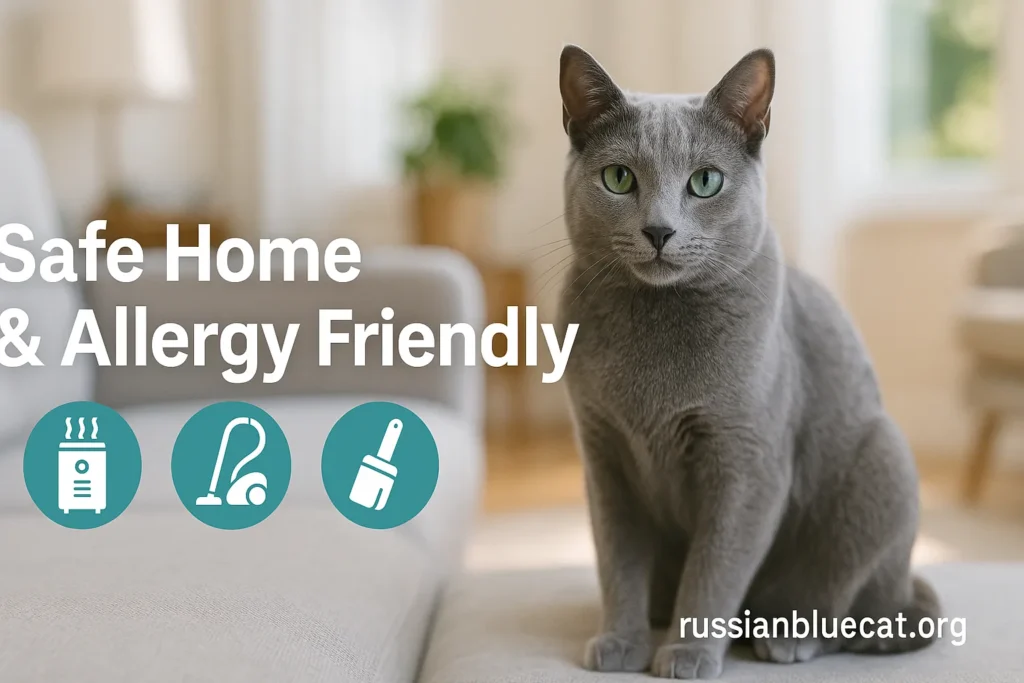
Russian Blues are also a good choice for mildly allergic people because their coat doesn’t shed as much dander into the atmosphere. However, living in ease has a few lifestyle adjustments to make.
Allergy-Prone Households Tips
- Brush Outside: Brush your cat outside or by an open window to keep floating fur at bay indoors.
- Air Purifiers: Purchase a HEPA purifier for living spaces and bedrooms.
- Clean Fabrics Weekly: Clean throws, cat beds, and curtains weekly to avoid allergen accumulation.
- Restrict Bedroom Access: A fur-free bedroom can be a game-changer.
Quite a few owners have noted that with these measures, Russian Blue Cat shedding doesn’t affect their allergies nearly as much as others do.
Debunking Shedding Myths
- Myth 1: Russian Blue Cats don’t shed. ❌ False. They do shed moderately, particularly in the spring and autumn.
- Myth 2: Shedding indicates poor health. ❌ Not always. Most shedding is natural and seasonal. Health problems result in excessive or abnormal fur loss.
- Myth 3: Hypoallergenic = no shedding. ❌ False. Hypoallergenic just means less allergens, not some kind of no-shed magic coat.
These myths explain what new owners need to have realistic expectations.
Long-Term Strategies for a Healthy Coat
Shedding isn’t only about fur it’s about health. Below are evidenced-based long-term routines to minimize Russian Blue Cat shedding and maintain your cat’s radiance:
- Balanced Diet: Omega fatty acids-rich, high-protein foods.
- Hydration: Engage your cat with fountains and moist food to increase water consumption.
- Stress-Free Environment: Consistent routines and peaceful areas minimize stress shedding.
- Regular Grooming: Keep brushing a love session rather than a chore.
- Vet Checkups: Regular yearly wellness checks prevent underlying problems from arising.
Consider coat care a part of your Russian Blue’s health plan, not housekeeping.
Russian Blue Cat Shedding FAQs
Conclusion: Embrace the Silver Sheen
Having a Russian Blue comes with the price of tolerating a bit of silver fur on your sweater or couch but in return, you are rewarded with loyalty, silent companionship, and that inimitable velvet coat.
Shedding is not a defect; it’s a normal part of the breed’s life cycle. With proper grooming, diet, and environment, Russian Blue Cat shedding is controlled and even predictable.
Having one of these cats is more about embracing their beauty and heritage than it is about battling fur. A little silver hair on your clothes is a small price to pay for sharing your life with such a refined feline.
